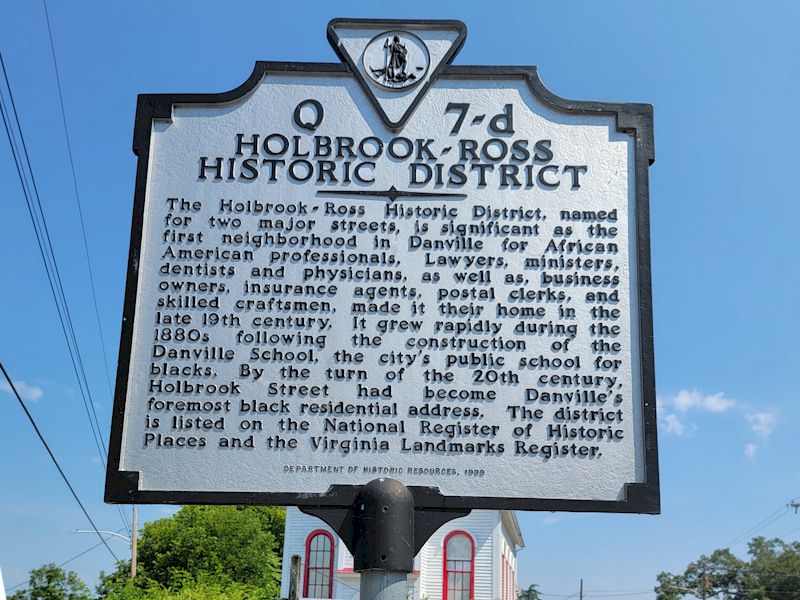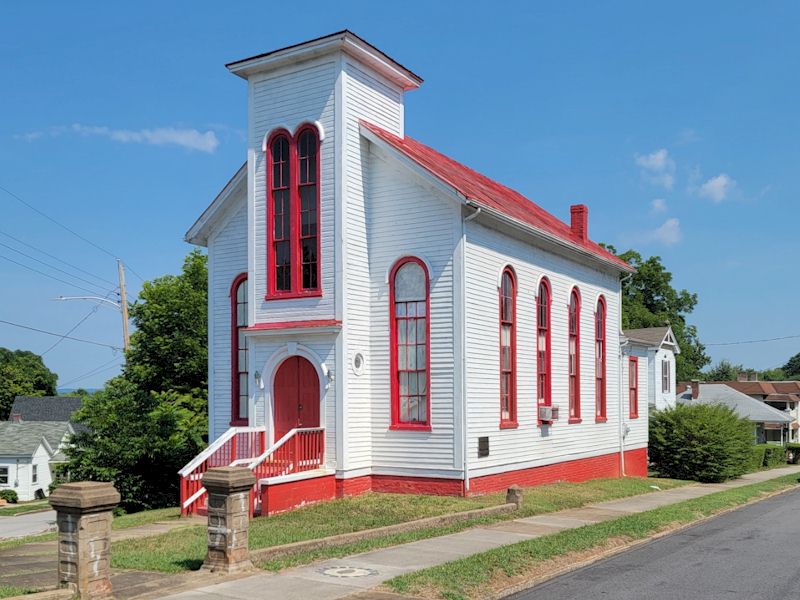Original Building of Sacred Heart Catholic Church – 102 Holbrook Street
Reproduced with permission from Victorian Danville – Fifty-Two Landmarks: Their Architecture and History © 1977
Located just outside the boundaries of the city’s Historic District [ed: now included in the Old West End boundary expansion area], this trim white frame building at the intersection of Holbrook and Ross streets is among the most visible and interesting structures in the area. It was built to serve as Danville’s first Catholic church.
Organized in 1875, the congregation is now known as Sacred Heart Catholic Church. That year, according to a brief history of the church compiled several years ago, the Holy Sacrifice of the Mass was first offered in Danville in the tailor shop of Mr. Kelley by Father McGurk of Lynchburg, Virginia. “The following year Bishop [James] Gibbons visited Danville and ‘lectured to quite a respectable audience, most of whom were Protestants.” The Richmond bishop (who later became a cardinal after he was transferred to Baltimore) and Father Donahoe arranged for a priest from Lynchburg to visit Danville once a month. Richmond also supplied priests for the Danville parish. Father Habets and Father James O’Farrell were the first two pastors of the church. During the ministry of Father Habets, at least $800 that had been collected was used for the construction of a church.
Sometime prior to June 1876, a large piece of land stretching almost to Union Street and roughly bounded by Ross and Holbrook streets was subdivided by its owner, Thomas B. Doe. In November of 1877, according to the deed of sale, Mr. Doe sold Bishop Gibbons lot number 59 “for and in consideration that the said James Gibbons shall have erected and completed thereon and dedicated for use a ‘Holy Catholic Church’ to be used only as such and also for the further consideration of five dollars …”
From examining several liens recorded from January through May of 1878, it is evident that at least four lumber dealers supplied lumber and finishing materials to the Crigler Brothers, contractors for the church building then under construction. The completed church was valued at $2,000, as recorded in the city land book of 1879. It was consecrated that same year by Bishop Jansen of Richmond, who later served as the archbishop of New Orleans, according to Beatrice W. Hairston’s book, A Brief History of Danville, Virginia, 1728-1954.

In February of 1886, subsequent to the construction of a rectory, Father F.X. McCarty became Sacred Heart’s first resident pastor. The church flourished, reaching a membership of 172 by 1923.
In 1938, under the pastorate of Father Joseph Brennan, work on the present Sacred Heart Church was begun. The site chosen was a corner lot where West Main and Randolph streets meet. [ed: This building is now a private residence.] On May 21 of the following year Bishop Peter Ireton of Richmond dedicated the new brick Gothic church designed by architects T.J. Collins and Son of Staunton, Virginia.
Sacred Heart’s first building at 102 Holbrook street was sold in 1948 to Mr. J. Frank Perkinson, president of Perkinson’s Foundry and Machine Company. Two years later Mr. Perkinson’s widow, Ida, sold the property to the Central Unit of Danville Company of Jehovah’s Witnesses, who retained the building until their move to a new building on the Piney Forest Road in the mid-1960s. The assembly, now called the Congregation of Jehovah’s Witnesses, Central Unit, or Kingdom Hall of Jehovah’s Witnesses, deeded their Holbrook Street property to the Congregation of Jehovah’s Witnesses, South Unit, in 1963. Nine years later the building was purchased by God’s Holy Temple, The Movement of Jesus Christ’s Holy Church, Apostolic Faith, whose members worship there today.
This simple but picturesque clapboarded church is given emphasis by its elongated windows with their semi-circular hood molds. The building gains visual importance for closing a vista at the junction of Holbrook and Ross streets. GG
[ed: This church building is now the unofficial entrance to the Holbrook-Ross National Historic District.]

